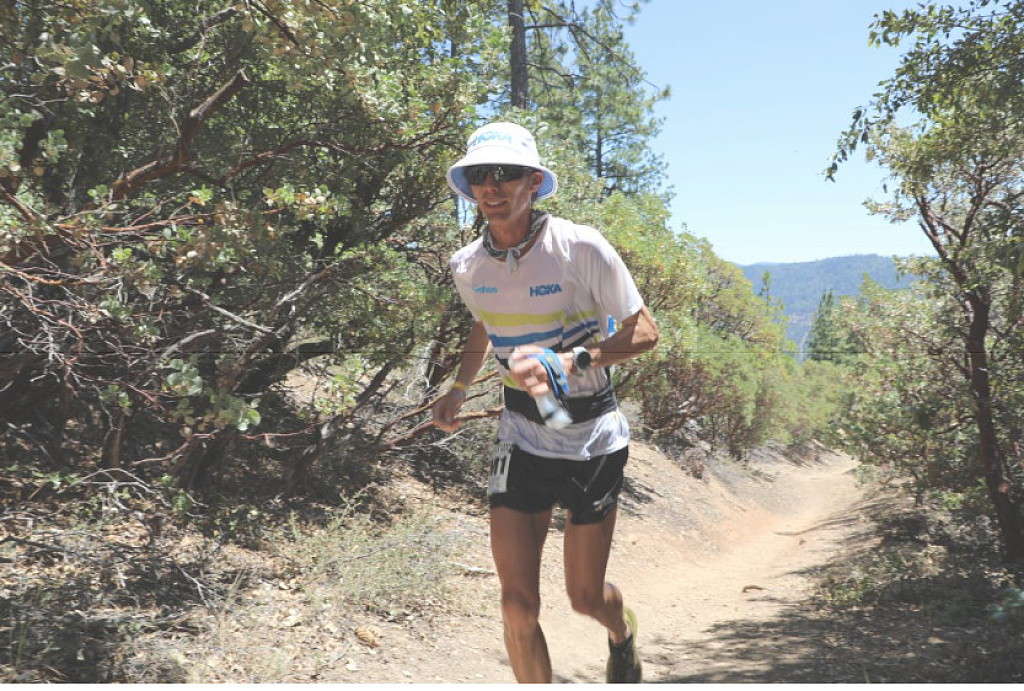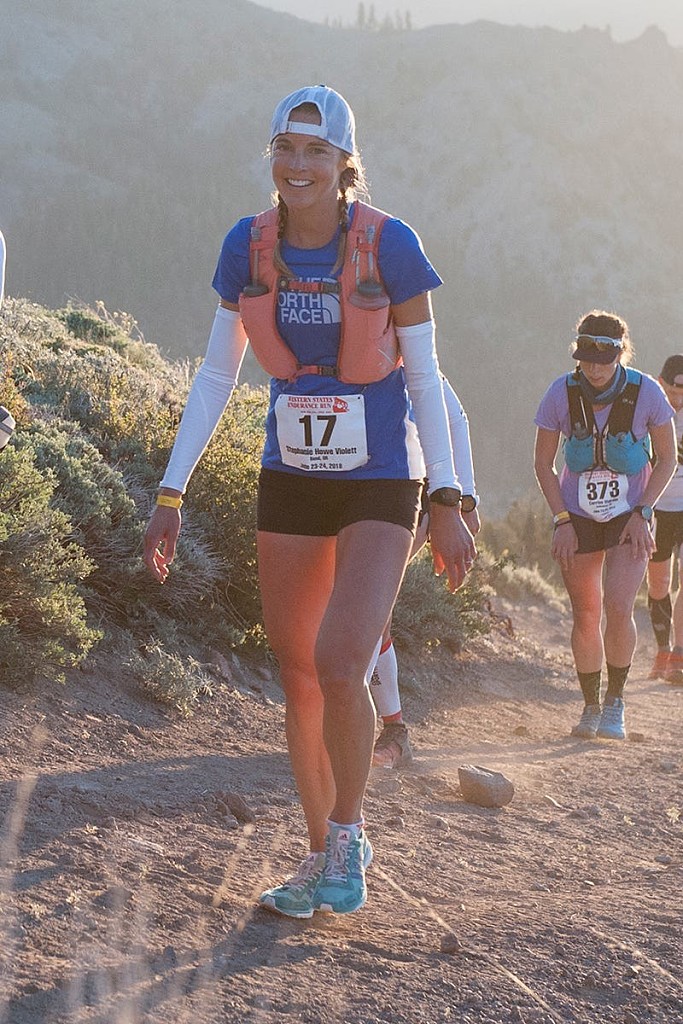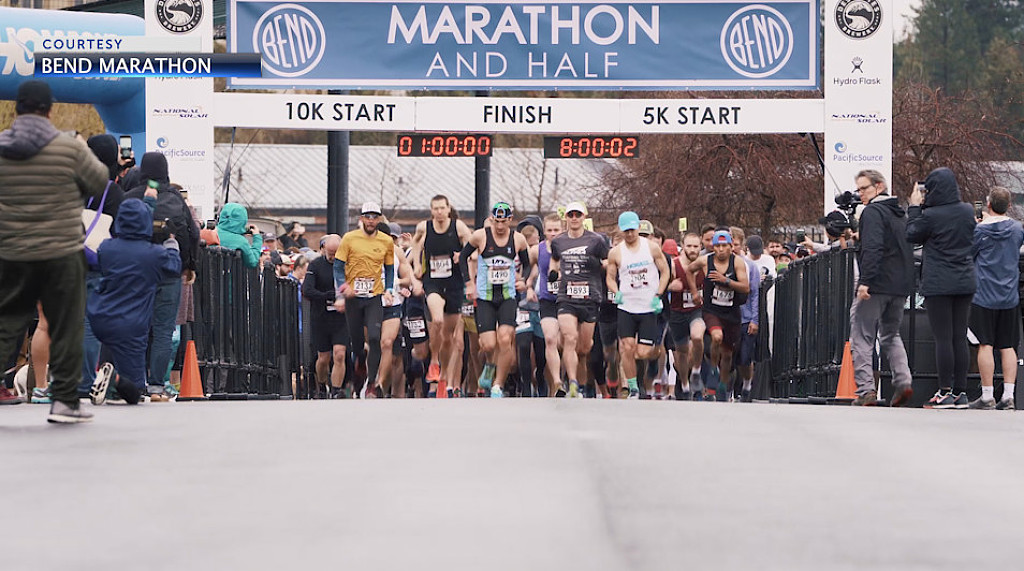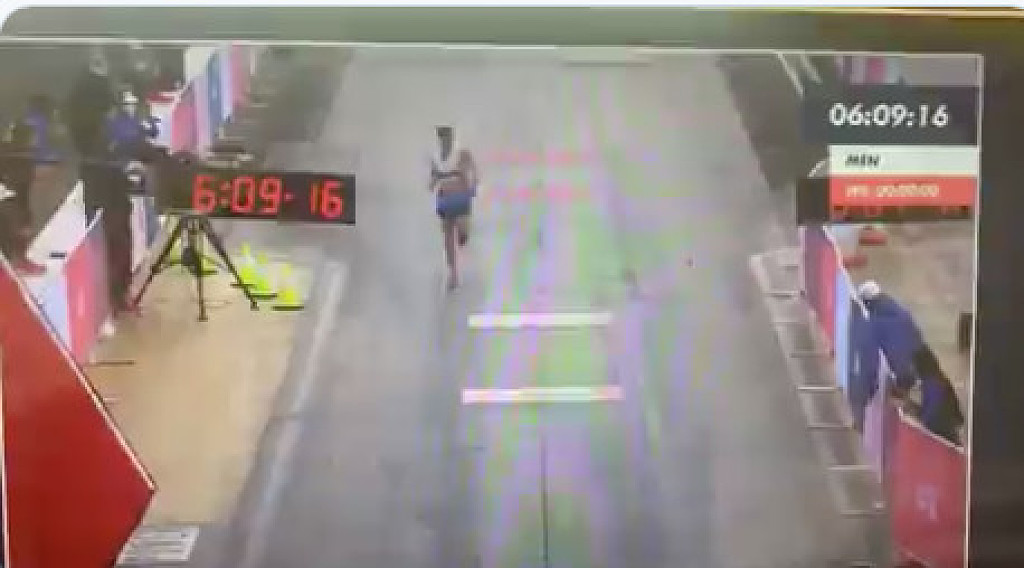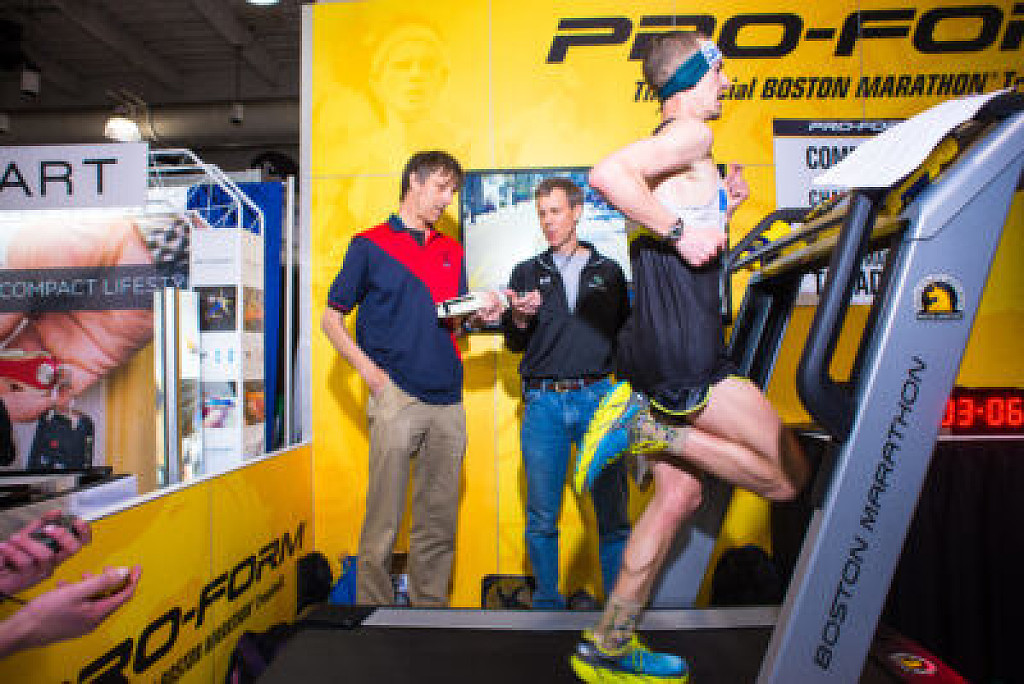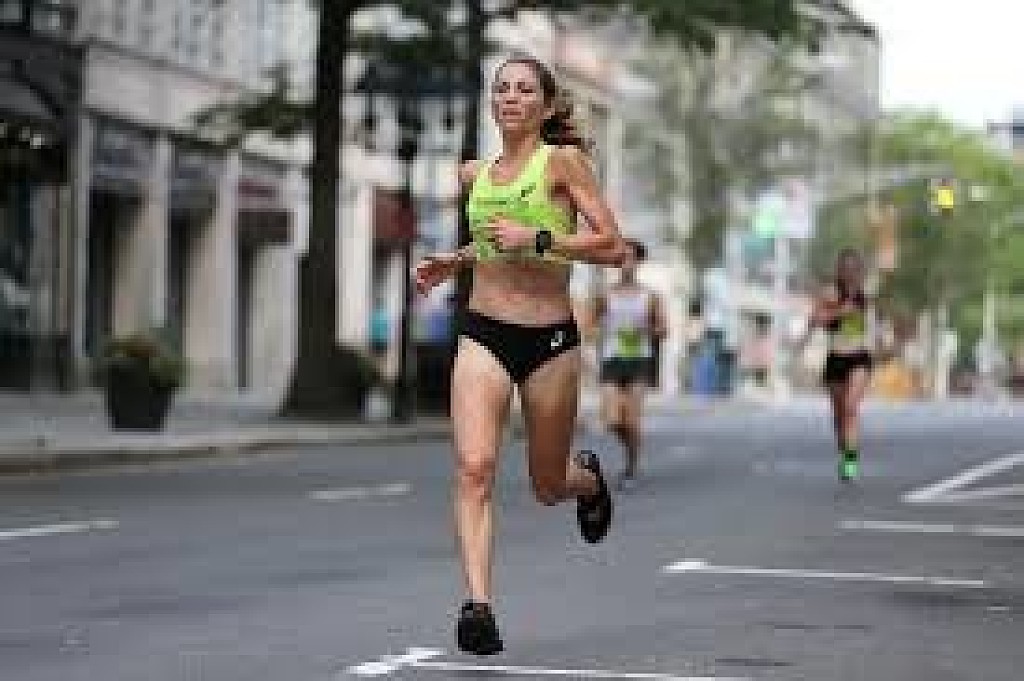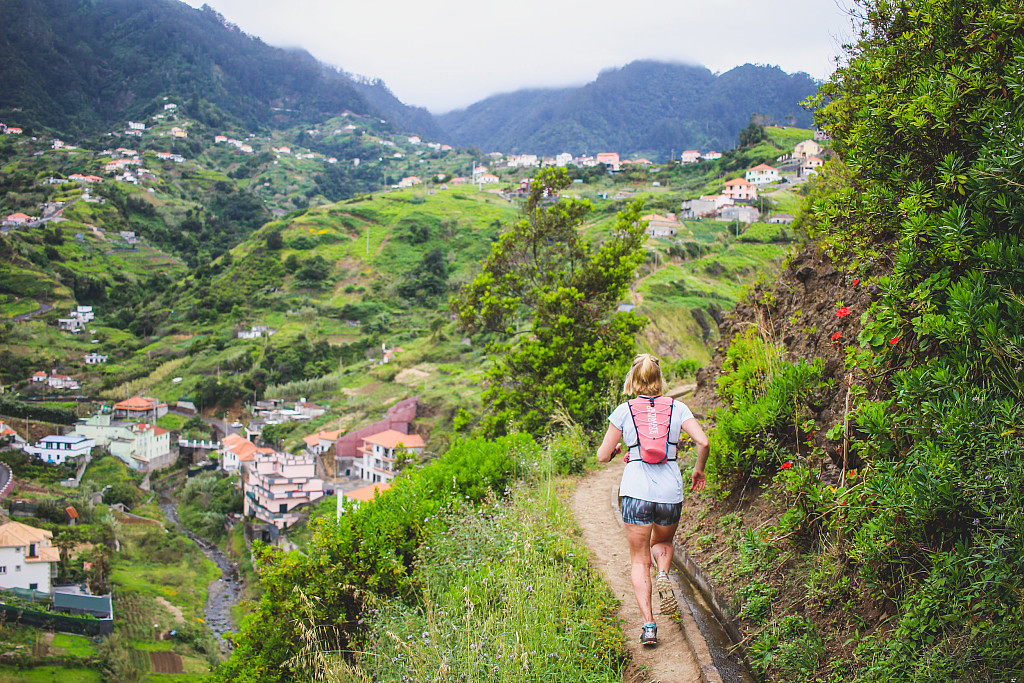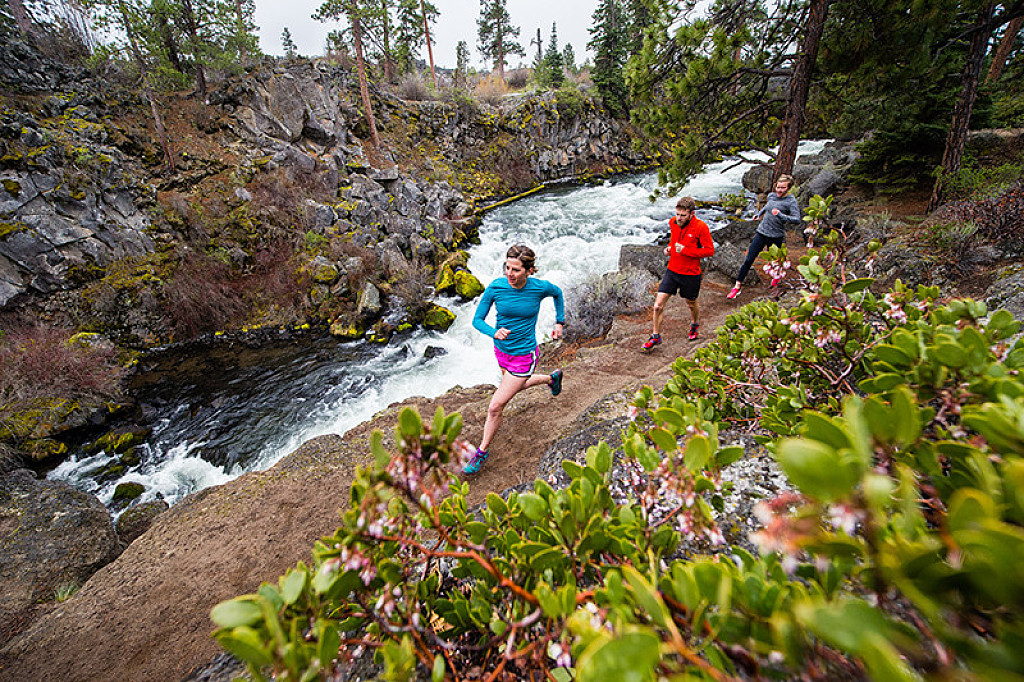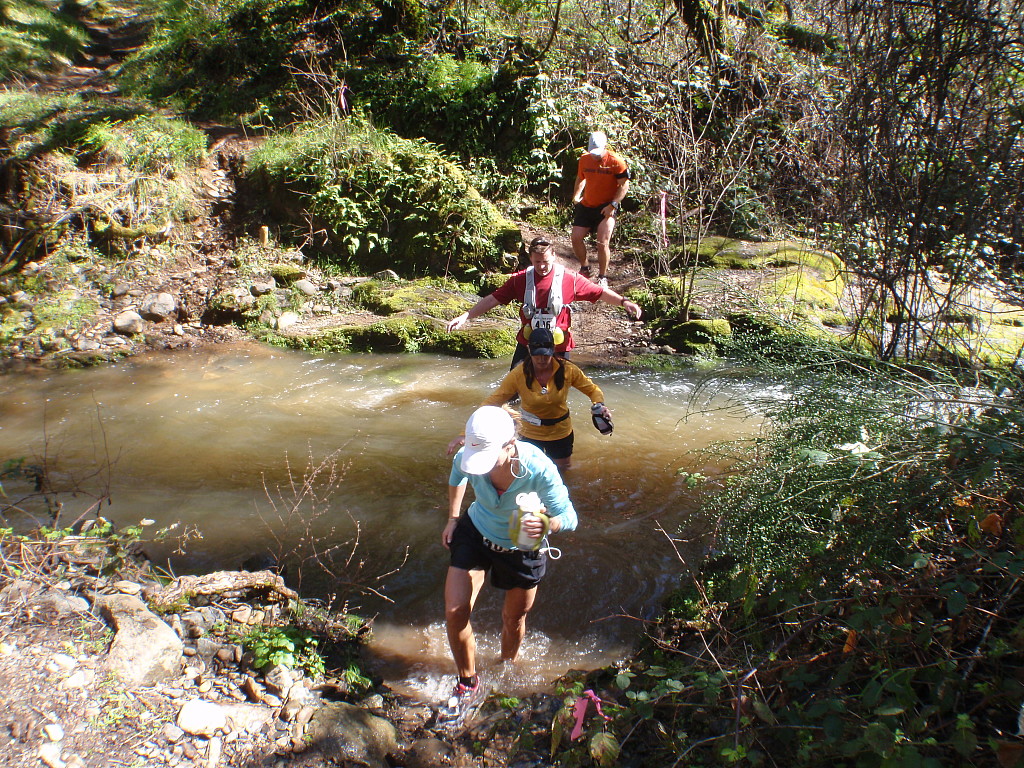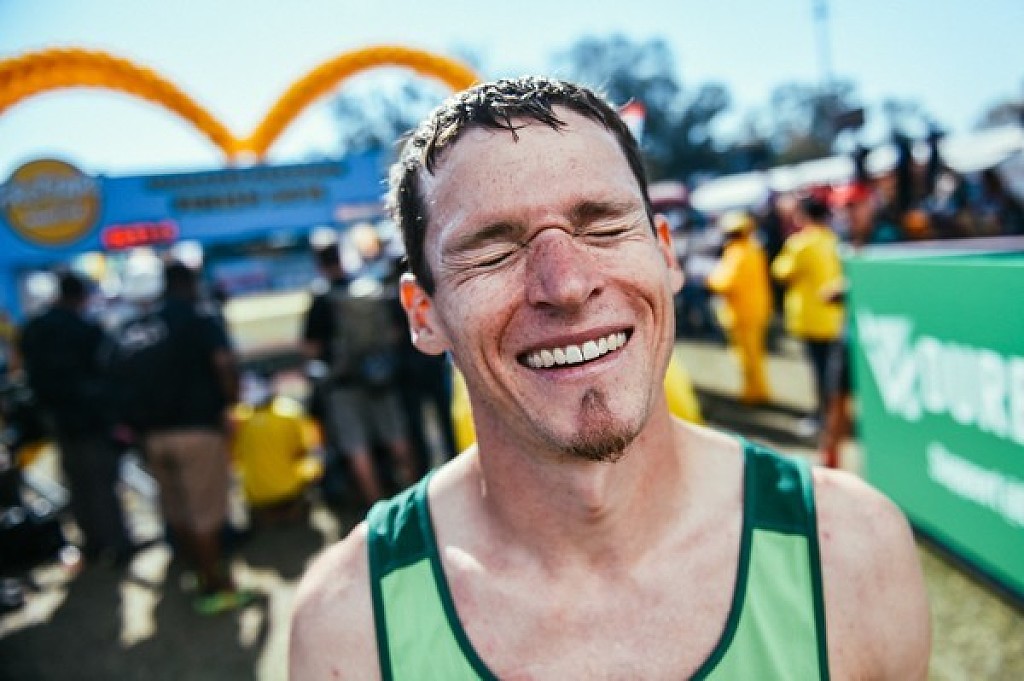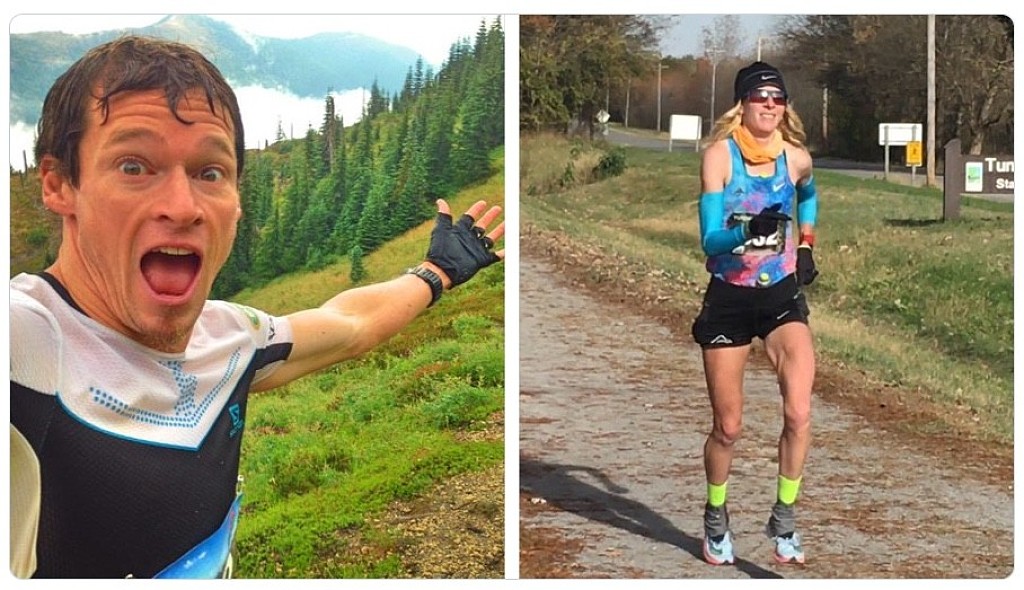Running News Daily
Running News Daily is edited by Bob Anderson. Send your news items to bob@mybestruns.com Advertising opportunities available. Train the Kenyan Way at KATA Kenya and Portugal owned and operated by Bob Anderson. Be sure to catch our movie A Long Run the movie KATA Running Camps and KATA Potato Farms - 31 now open in Kenya! https://kata.ke/
Index to Daily Posts · Sign Up For Updates · Run The World Feed
Articles tagged #Max King
Today's Running News
2021 Western States 100 Men’s Race
It would have taken a lot to convince most everyone to bet against Jim Walmsley (pre-race interview) this year. And yet some of us still somehow did, because Walmsley took an unconventional path to 2021 success. But we all should have known better.
With many of the international men choosing not to make the trip over the various ponds, it was going to be a showdown of domestic talent. Listening to Walmsley talk before the race, it was clear he was in a good place mentally and physically. An IT band injury in the spring may have cut down on his training volume, but in the end, it may have ended up being a blessing in disguise. He went into the race with the experience of two well-executed States performances, and he surely he drew on that knowledge to put together a smart and measured race from start to finish.


Hayden Hawks (pre-race interview), on the other hand, was making just his second attempt at the 100-mile distance. But after setting a course record at the JFK 50 Mile last fall and a solid block of training leading up to Western States, he was out to race and win. Jared Hazen (pre-race interview) was hoping that fourth time would be the charm for Western. After a third and a second in previous years, he hoped that a training block that started in February would deliver results.
It didn’t take Walmsley long to make it the 3.5 miles up to the Escarpment. He was accompanied by Hawks and followed closely by Hazen. This order was entirely unsurprising given that all three men had the confidence to try to win the race.
Early on at Red Star Ridge at mile 15, Hawks and Walmsley were already running three minutes under record pace, the lack of snow clearly saving them time. Hazen followed in third two minutes back with other race favorites Tim Tollefson (pre-race interview), Matt Daniels (pre-race interview), and Mark Hammond close on his heels. Just under an hour later at Duncan Canyon, Walmsley and Hawks had pushed the pace another four minutes under record pace, both running smooth at 24 miles in.
By Robinson Flat at mile 30, Walmsley’s pace had become too much for Hawks. He passed through five minutes under course record pace and 45 seconds in front of Hawks. By this time, Tollefson, running toward his childhood home in the foothills of the Sierra Nevada, had moved into third, just over 12 minutes back, looking very relaxed. Thirty seconds later, Hazen came through, already looking decidedly rough.
Sometime before mile 38, Walmsley had donned a bucket hat and continued to cruise at six minutes under record pace, slowly pulling away from the rest of the field. Hawks held the gap to just six minutes while Hazen and Tollefson joined forces nearly 17 minutes back. The likes of Alex Nichols (pre-race interview), Drew Holmen, and Max King stayed close, just another seven minutes back.
By mile 50, Walmsley had put eight minutes into the course record. Maybe it was the bucket hat, but the only word to describe his appearance was relaxed. It was a full 26 minutes later before second place Hawks rolled through, still seemingly running within himself. Nichols led Tollefson through, both looking strong. Hazen continued to suffer, dropping back to fifth.
By the time the leaders rolled through Foresthill at mile 62, it was 93 Fahrenheit in the shade and 97 in the sun. It was time for the heat management strategies to come into play. “It’s not the heat, it’s the hills,” said Hawks, coming through after losing 10 minutes to Walmsley in the previous five miles. He was now 48 minutes back and had Nichols to contend with who was slowly closing the gap.
That ever-infamous Cal Street, stretching between Foresthill at mile 62 and the Rucky Chucky river crossing at mile 78, is where the day started to catch up to Walmsley—just a little bit. At the Cal 2 aid station, he’d given back his advantage on the course record. From there on out, he moved faster than everyone else behind him, but slower than a 2019 Walmsley.
By Green Gate at mile 80, Walmsley was five minutes over course-record pace. But Hawks came through a full 77 minutes back. A surging Holmen was just 11 minutes behind and didn’t even stop. This was his first attempt at 100 miles, and he’d clearly done his homework on pacing and patience. Tyler Green was close behind. With a 14th-place finish at Western States in 2019, Green was on a mission to do better.
By the time Walmsley made it to Robie Point, just a mile to go, and with the course record was off the table, he stopped for a Coke and walked the climb. He would continue to cruise the final mile in his bucket hat to win his third Western States in a row with a time of 14:46:01.
Behind him, the race for the podium stayed intense. Somewhere between Green Gate and Pointed Rocks at mile 94, Hawks disappeared from the front of the race, leaving Green in second place with Holmen chasing just six minutes back. Cody Lind followed in fourth and just 17 minutes back.
At the end, Green would hold off Holmen with a time of 16:11:00 to take second, a massive jump up from his 2019 finish. Holmen completed the podium with a time of 16:23. Both had started off conservatively and had it pay off in the end.
Lind would finish fourth in 16:49:40, an impressive run for his first 100 miler and first attempt at Western States. He clearly had insider’s knowledge as the son of two-time Western States finisher Paul Lind and the grandson of the event’s original medical director Dr. Bob Lind.
Tollefson rounded out the top-five men with a time of 16:55:49. He’d put off running Western until he felt ready to do the race justice, and clearly, he was ready. The fact that he’d grown up in the area and run the last miles of the course hundreds of times certainly paid off in the race’s most difficult miles.
In the back half of the men’s top 10, we had sixth-place Kyle Pietari, who executed yet another well-played top-10 performance, Stephen Kersh who finished seventh for the second time in a row after curiously bouncing around almost all the top-10 positions over the course of the day, and Hawks who ultimately crossed the line in eighth place after experiencing physical struggles and a long stay at the mile 94 aid station to regroup.
Among the day’s breakout runs was ninth place Kyle Curtin, who moved up into the top 10 late. And Nichols rounded out the top 10 in what looked like a difficult finish after an even more difficult day.
And just to clear the air for those wondering, Daniels DNFed at mile 55. Hazen and Jeff Browning left the race at mile 62. And Hammond and King tapped out at mile 80.
by I Run Far
Login to leave a comment
The Western States 100 Is Back and It’s Going to be HOT!
Western States is famously competitive - and this year is shaping up to be one of the toughest competitions yet with hot temps, and a stacked field.
Jim Walmsley and Magda Boulet will be back at the Western States Endurance Run this week.
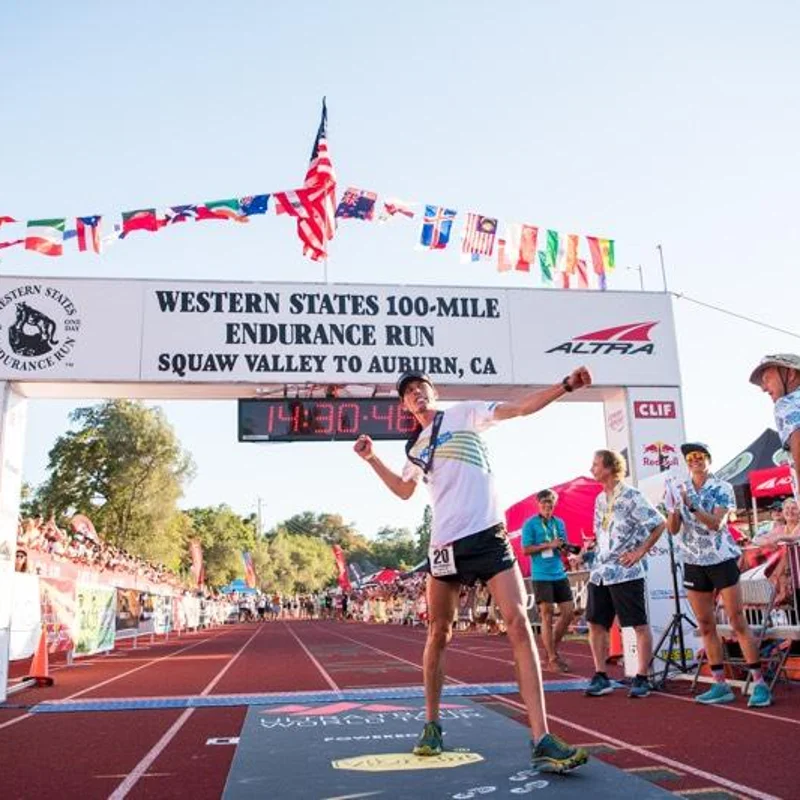
And so will Clare Gallagher, Patrick Reagan, Max King and Brittany Peterson. And, so too is race pioneer Gordy Ainsleigh and 312 other inspired runners who have been training for more than a year and a half to get to the starting line. In fact, we’re all heading back to the Sierra Nevada range this weekend — even if vicariously — to what feels like a bit of normalcy returning.
After a year mostly away from the trail racing running scene, things are starting to feel like old times. With stacked men’s and women’s fields, scorching heat in the forecast and last year’s Covid-19 hiatus hopefully mostly behind us, it’s definitely the event the ultrarunning community has been looking forward to. The race begins at 5 a.m. PST on June 26 and it looks like it’s going to be an epic one. (Follow via live tracking or the live race-day broadcast.)
“Yeah, it will be good to be there and see people and actually be in the race,” says Walmsley, who won the race in 2018 and 2019 in course-record times. “It’s been an odd year.”
Odd for sure, but with deep men’s and women’s fields, hot weather, dusty trail conditions and the late June gathering of a few hundred runners on this hallowed ground feels somewhat normal. The mountains and canyons in and around Olympic Valley northwest of Lake Tahoe have been a sacred place for the native Washoe people for thousands of years before Gordon Ainsleigh’s first romp over the Western States Trail in 1974.
It’s been an especially odd year for Walmsley, who, for the second straight year, had planned to use the first half of his year training for the 90K Comrades Marathon in South Africa. But that was canceled last year (with just about every other big race, including the Western States 100) and this year, too.
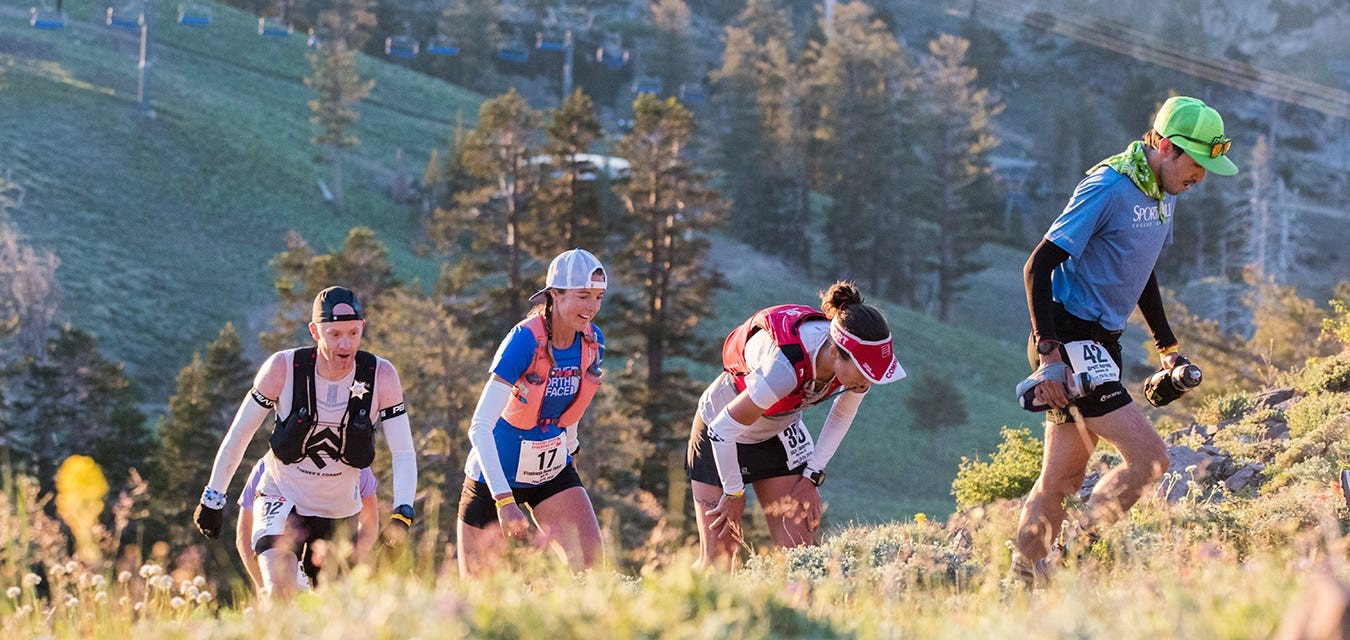
So instead, after setting a new U.S. 100K road record in January, he took a sponsor’s entry into the Western States 100 from HOKA One One and will be once again lining up in America’s most celebrated trail running race. With notable first-timers Tim Tollefson and Hayden Hawks in the mix along with Walmsley, Reagan, King, Matt Daniels, Alex Nichols, Kyle Pietari, Mark Hammond, Stephen Kersh, Jeff Browning and Jared Hazen all returning with previous top-10 finishes, on paper anyway, the men’s race is shaping up to be one of the most competitive in recent memory or maybe ever, even though it’s comprised entirely of domestic runners.
The women’s race might be even more competitive with former champions Boulet, Gallagher (2019) and Kaci Lickteig (2016) leading the way, plus elite American runners Camille Herron, Addie Bracy, Camelia Mayfield and Keely Henninger and international stalwarts Ruth Croft (New Zealand), Audrey Tanguy (France), Beth Pascall (UK), Emily Hawgood (Zimbabwe), Kathryn Drew (Canada) and Ragna Debats (Spain) joining the fray.
Who are the favorites? It’s hard to tell. Most of those runners, including Walmsley and Boulet, have admitted to having dealt with some minor injuries, inconsistent training, a lack of motivation and other setbacks over the crazy year that was. Based on what runners have been reporting, it seems like most are just eager to get back and immerse in a competitive 100-miler and see what they can do.
However, one of the keys will certainly be who can survive the heat the best. The forecast is calling for high temperatures in the upper 80s to the high 90s on Saturday after and the canyons between Robinson Flat and Michigan Bluff could even reach over 100 degrees.
Walmsley has said he’s dealt with some IT band issues and has focused mostly on running with a lot of vert, focusing on getting optimal recovery, strength sessions and body work, as well as spending as much time running in extreme heat as possible. That includes running and hiking countless laps to the summit of 9,298-foot Mt. Elden in Flagstaff, averaging 20 to 25 hours per week on the trails and also spending a lot of time on a bike trainer.
But he’s also spent a lot of time in the infrared sauna in his home and spent time with family in the Phoenix area, where he ran in the afternoons amid 115- to 120-degree heat.
“The heat training is kind of lucky for me, because growing up in the heat in Arizona, I didn’t know any different,” Walmsley says. “I just thought everyone was roasting in the heat. It’s what I grew up with and I try to lean into those memories and embrace the heat.”
Boulet, who lives in Berkeley, Calif., has also gone out of her way to train in the heat. While she says her build-up has been inconsistent compared to previous years, she’s been doing a lot of climbing and descending in the heat, and also working on box jumps to strengthen her legs for the long descent into Auburn. She says a recent 40-mile run up 3,849-foot Mt. Diablo east of Berkeley, is a good indicator that she’s ready to roll.
“I’ve definitely been spending more time in the heat lately, which is something I personally don’t enjoy running in,” says Boulet, who won the race in 2015, DNF’ed in 2016 and placed second in 2017. “But I know the importance of preparing in the heat and falling in love with running in the heat by race day. You can be as physically as ready as possible in terms of your fitness, but if you don’t have the heat training and you’re trying to tackle some of the parts of the canyons that are in the middle of the race, It’s really tough.”
Given the extreme heat, it’s not likely that anyone will challenge Walmsley’s 14:09 course record set two years ago, when it was in the low-80s and cloudy on race day. But there’s also no snow on the course this year, so the early sections that have previously forced runners to hike and walk early on will likely be faster, and that will likely result in fatigue that will slow them down in later stages of the race.
“You’ve got to take what the course gives you,” Walmsley says. “I’ve learned that you don’t fight the course where you shouldn’t. I have some splits in mind that would get me there under 15 hours and maybe close to 14:30, but it’s going to be all about feeling out what the course is giving me, following those guidelines and not forcing it. Because anyone who forces it in that heat will be doomed.”
by Outside Online (Brian Metzler)
Login to leave a comment
Western States 100
The Western States ® 100-Mile Endurance Run is the world’s oldest and most prestigious 100-mile trail race. Starting in Squaw Valley, California near the site of the 1960 Winter Olympics and ending 100.2 miles later in Auburn, California, Western States, in the decades since its inception in 1974, has come to represent one of the ultimate endurance tests in the...
more...Bend Marathon has been cancelled for the second consecutive year
Of all the sporting events that have been canceled over the past year in Central Oregon, perhaps none has endured worse luck than the Bend Marathon.
The event — which was scheduled for April 18 and includes a marathon, half marathon, 10-kilometer, and 5K race on roads and paved trails throughout Bend — has been canceled for the second consecutive year due to the COVID-19 pandemic.
One of the first major events to be canceled in 2020 at the onset of the pandemic, the sixth edition of the in-person Bend Marathon will now be pushed back to 2022.
At last week’s Bend City Council meeting, councilors were unable to come to an agreement on issuing the Bend Marathon a special event permit.
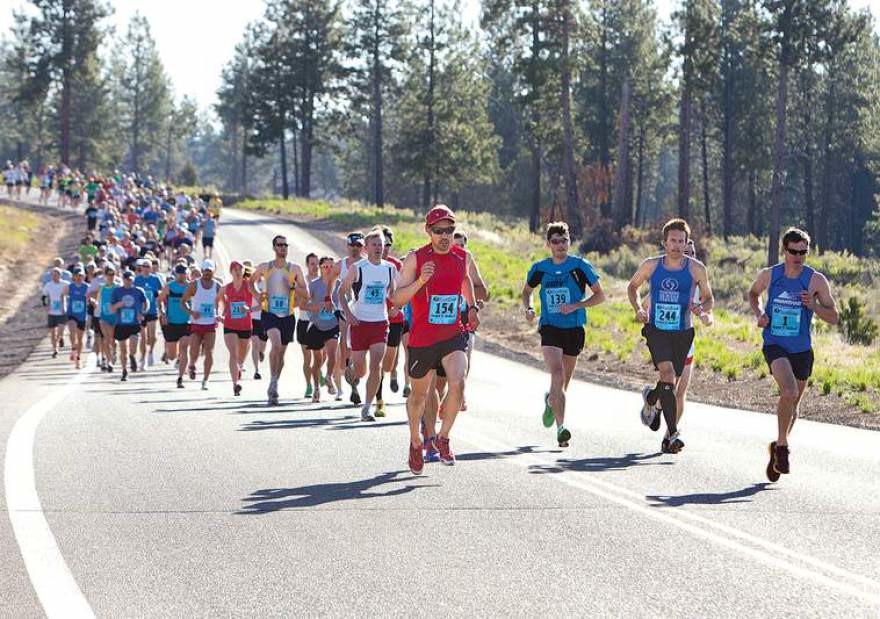
Of all the sporting events that have been cancelled over the past year in Central Oregon, perhaps none has endured worse luck than the Bend Marathon.
The event — which was scheduled for April 18 and includes a marathon, half marathon, 10-kilometer, and 5K race on roads and paved trails throughout Bend — has been canceled for the second consecutive year due to the COVID-19 pandemic.
One of the first major events to be canceled in 2020 at the onset of the pandemic, the sixth edition of the in-person Bend Marathon will now be pushed back to 2022.
At last week’s Bend City Council meeting, councilors were unable to come to an agreement on issuing the Bend Marathon a special event permit.
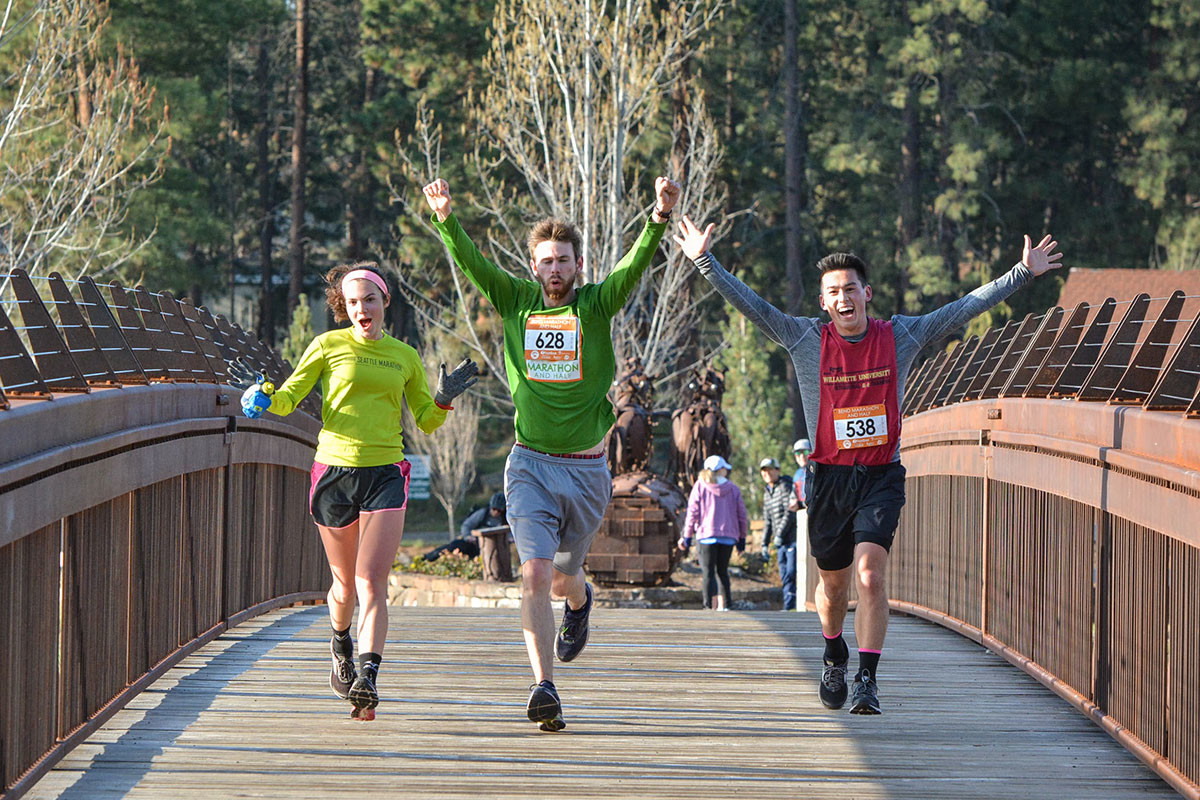
Marathon organizers Max King and Kari Strang had submitted a proposal that featured several safety protocols, including wave starts of no more than 75 runners, which would adhere to state and county guidelines for outdoor gatherings.
“They didn’t want to risk it,” a disappointed King said. “The spirit of the guidelines are that you don’t get that many people together, and we weren’t getting that many people together.”
King said he was expecting a total of about 900 runners across the four races. About 600 had registered before the event was canceled. In 2019 more than 2,400 runners and walkers participated in the Bend Marathon’s events.
The Bend Marathon course was to feature Bend parks, neighborhoods and the new paved trail through the Deschutes National Forest (paralleling the Cascade Lakes Highway).
King called it bad timing for the popular event.
“We obviously don’t want to spread the disease, and that is what people are risk adverse to,” King said. “When we look at other things that are already happening in the community, such as Mt. Bachelor, restaurants and retail being open, and the lack of spread in outdoor events and the risk being really, really low, I don’t agree with where they’re coming from.”
King and Strang were also planning to decrease aid stations, require masks at the start and finish, and not allow spectators.
The 2021 Bend Marathon will still offer a virtual option, as it did last year. Participants can run their distance wherever and however they want from April 12 to May 25, and then upload their finishing time to bend-marathon.com.
“We want to hype it up and make it fun for people,” King said. “We don’t want it to be just an afterthought. We’ll do some fun events around the race time and some fun videos about training.”
And for now, the plan is certainly for an in-person Bend Marathon in 2022.
by Mark Morical
Login to leave a comment
Bend Marathon and Half
Welcome to the Bend Marathon, Half, 10k and 5k. We're excited that you're considering running with us. You'll cruise around neighborhood parks, through Ponderosa Pine forests, along the mighty Deschutes River and finish in a beautiful iconic Bend location to a hoppin' afterparty where the kombucha and craft beer are flowing, food carts are waiting, and you can relax because...
more...Jim Walmsley Shatters the 100K American Record, But Misses the World Record by 11 Seconds
The king of Western States came so close at the Project Carbon X 2 race.
After more than six hours of running, Jim Walmsley crossed the finish line 11 seconds short of his ultimate goal—the world record in the 100K.
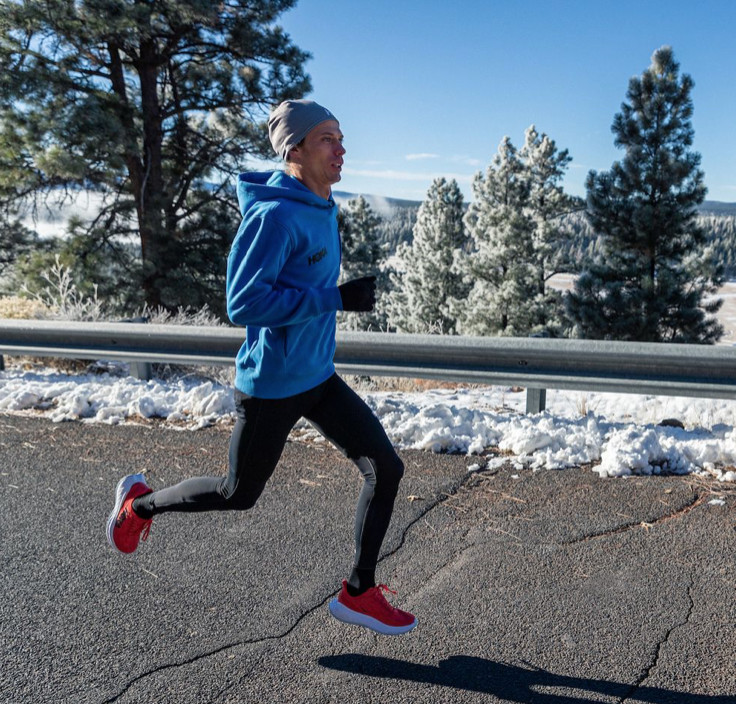
At the Hoka Project Carbon X 2 100K race on January 23, held in Chandler, Arizona, Walmsley ran 6:09:25, shattering the American record of 6:27:44, set by Max King in 2014. But the world record (6:09:14, set by Nao Kazami in 2018) continues to elude him.
“Definitely feels like one of the more special runs I’ve had,” Walmsley said, in his post-race interview. “Really felt like I got everything out of myself today, dug real deep, and fought all the way to the line. I don’t feel like I gave up, but it was tough to see the seconds tick by. It’s a little bittersweet, but definitely awarded with an American record today, and those don’t come very often. I don’t get to do things like this in my home state very often, so it’s extremely positive. A 45-minute PR. It was a pretty amazing day.”
Nineteen men and women were chasing national and world records in the 100K distance in Saturday’s race. Walsmley was the men’s favorite to set both the world record and the American record, while Camille Herron was favored for the women. Herron was forced to drop out of the women’s race with a hip injury.
Walmsley started the race in a pack with five other runners, running conservatively to keep his legs fresh. But the other four runners faded behind him, leaving Walmsley to chase the record alone. His pacing picked up over the final 30K, as he raced the clock with everything he had.
Around the 3:30 mark in the race, Walmsley clipped his left shoulder on a course sign, and he was visibly bleeding for the next two and a half hours. At water stops, he’d fuel and treat his wound as best he could while keeping his stride.
The race came down to the final 10K, as Walmsley needed to run 37:58 or faster over the final miles. Those watching the race on the live stream could see the fatigue and pain set in over that final stretch. He let out a loud “C’mon, Jim” scream with a little more than 5K to go, fighting the clock with everything he had.
As he entered the drag strip to the finish, he had just over a minute to cover the final hundreds of meters. He got on his toes, repeatedly checked his watch, and ran as hard as he could to beat the clock that was now in his sights. Ultimately, he watched the clock tick past 6:09:14, finishing 11 seconds later.
“We’ll have to try it again,” Walmsley said in his post-race interview. “We’re in the right ballpark and on the right track and we have a shoe to compete with this and we’re knocking on the door. I don’t think I’m done with the 100K. Fortunately, unfortunately, there’s likely another one down the road.”
The remainder of Walmsley’s year is uncertain, because of the pandemic. He told Runner’s World before the race that he’s looking at first are the Comrades Marathon and the Ultra-Trail du Mont-Blanc. In the near future, he’s hoping to do the Black Canyon 100K three weeks from this weekend on February 13.
The Flagstaff, Arizona, native wasn’t the only runner with a notable day out on the course. Rajpaul Pannu took second in the men’s 100K in his first-ever attempt at the distance. Pannu is a math teacher in addition to being a pro runner who finished 63rd at the Olympic Marathon Trials in February 2020.
In the women’s race, the United Kingdom’s Carla Molinaro and the United States’s Camille Herron led for the first half of the race before France’s Audrey Tanguy slowly made her way past both runners early in the second half of the race. After that, Herron was forced to drop out after six of nine laps due to a hip injury.
Tanguy, the reigning and two-time champion of the Ultra-Trail Sur les Traces des Ducs de Savoie (TDS), captured the lead and ran away with the race for the win in 7:40:35, unofficially.
American Nicole Monette did move close to Tanguy late in the race and took second, finishing less than three minutes behind the winner.
by Runner’s World
Login to leave a comment
Jim Walmsley, Hayden Hawks Going for 100-km World Record at Project Carbon X 2 in Arizona
A group of top ultra runners will gather in Chandler, Ariz., with hopes of breaking the World Athletics records for 100 kilometers on the road. The event, called Project Carbon X 2 and staged by Hoka One One for the benefit of their athletes, will start and finish at the Wild Horse Pass Motor Sports Park and will use some of the same roads as The Marathon Project which was held with great success last month.
“I’m incredibly excited,” said Hoke One One president Wendy Yang on a video conference today with reporters. “Also feel super fortunate that the team was able to bring this event together.”
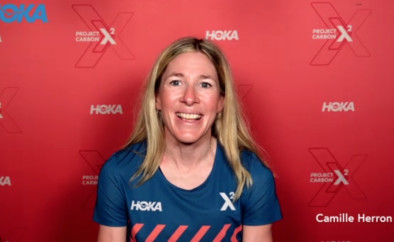
The pandemic has meant dramatically fewer competitive opportunities for road running athletes, especially ultra runners who specialize in distances longer than the standard marathon distance of 42.195 km, or 26.2 miles. However, since most ultra runners train alone or in very small groups, the pandemic has given them a chance to put in long blocks of uninterrupted, COVID-safe training and improve their strength and fitness. Tomorrow’s race will offer them a chance to show off their work.
We wanted to give our athletes the chance to compete,” Yang continued. “We felt like our athletes really needed this chance.”
The top targets for tomorrow’s race are the ratified World Athletics 100-K records of 6:33:11 for women, set by Japan’s Tomoe Abe in 2000, and 6:09:14 for men, set by Japan’s Nao Kazami in 2018. Both records were set at the same event, the Lake Saroma 100-K in Hokkaido, Japan. The women’s record works out to a pace of 3:56 per kilometer, which means running two 2:46 marathons back-to-back plus another 15.6 kilometers at the same pace. The men’s record pace of 3:42 per kilometer translates to running back-to-back 2:36 marathons plus the extra distance.
“You never know what can happen in an ultramarathon,” said Hayden Hawks one of the top contenders in the men’s division. Hawks smashed the course record at the venerable JFK 50 Mile (80.5 km) in Maryland last November, clocking 5:18:40. His pace at that event, which included rugged trails and some steep climbs and descents, worked out to 3:58 per kilometer. He said he’s been practicing on flat, loop courses to simulate the conditions in Arizona, and that with his strength and mental toughness he has a chance at the record.
“My greatest strength is probably just my stubbornness,” Hawks said. He added: “I feel like I have this mental strength to push through a lot of pain.”
Hawks’s main rival tomorrow will be ultra star Jim Walmsley, the man whose record he broke at the JFK race. Walmsley is best known as a trail runner, and is the course record holder for the impossibly difficult Western States 100-Miler in Auburn, Calif., where he ran 14:09:28 in 2019 (he also won in 2018). Walmsley already holds the world best for 50 miles on the road of 4:50:08. Using the popular Riegel Formula, that’s equivalent to 6:05:51 for 100-K, comfortably under the 100-K world record by more than three minutes.
Note: Walmsley was on the LetsRun.com Track Talk Podcast this week where he talked about his 100-k world record attempt, his big plans for 2021 and his cancelled 2020. Highlights here.
“I’m really looking forward to improving on my past performances in the 100-K,” Walmsley said today, admitting that he hasn’t yet perfected his approach to that distance yet. He continued: “I think I’m bringing a more mature approach of being more patient.”
If they don’t eclipse the world record, both men could surpass Max King’s USA record of 6:27:44 set in 2014.
On the women’s side, Camille Herron is the top entrant, and she rated her fitness at “80 to 85 percent.” Like Hawks, the holder of the world best for 24 hours on both the road and the track recently won the JFK 50-Miler. She played down the possibility of getting the world record, but said she was in about the same shape as when she won the famed Comrades Marathon in South Africa in 2017 over a distance of 86.73 kilometers. She allowed that a personal best (sub-7:08:35) was possible, despite only doing a six-week build-up.
“I’m definitely confident in my fitness,” said Herron who recently switched sponsors from Nike to Hoka One One and who will be doing her first race in Hoka shoes. She added: “I’m getting fitter every week. I have a pretty good idea of what I’m capable of.”
Also competing in the women’s division is Irish Olympic marathoner Caitriona Jennings, 40, who will be making her 100-K debut. Jennings will be taking a cautious approach to the race because she is 12 weeks pregnant. She said that there will be plenty of ice and fluids available on the course so that she can keep her core temperature in check.
“It wasn’t a decision I took lightly,” she said emphasizing that she had consulted with her doctor before agreeing to compete. She added: “I think (the water and ice on the course) will help with hydration and keep my temperature down.”
The athletes will start and finish on the race track, and will run about nine laps of an 11-kilometer circuit (Walmsley estimated that each full lap would take him about 41 minutes). The course was measured by two World Athletics “A” measurers, Joe Galope and Jay Wright (an “A” measurer must be used in order for a course to be eligible for a World Athletics record). The event will have in-competition drug testing done by the USA Anti-Doping Agency, also a requirement for setting a world record.
All of the competitors will be wearing the new Hoka One One Carbon X 2 shoe. Colin Ingram, Hoka’s director of product, called the new shoe “one of our sharpest tools in the box.” He explained that the shoe had been improved over its predecessor by incorporating “swallow tail construction” to improve deceleration on the foot strike, and lowering the carbon plate to get it closer to the ground.
“It allows for a more natural gait,” Ingram said.
While Hoka One One has not disclosed the cost of the event, it is significant, especially making it as safe as possible from the coronavirus. Mike McManus, Hoka’s director of global marketing, said that every athlete had at least three antigen PCR tests in the last week, and that masks and social distancing were required at all times except when the athletes are on the course. An industry insider contacted by Race Results Weekly estimated the cost of COVID mitigation for the event was around $60,000.
“It’s been a huge challenge for us to make this event happen in a very safe way,” McManus said.
The race will be streamed live and free at hokaoneone.com beginning at 9:00 a.m. Eastern Standard Time.
by Let’s Run
Login to leave a comment
Sara Hall Among Pros Who Will Take Shot at Treadmill World Records on June 6 in Chaski Challenge
Inspired by the success of last month’s Quarantine Backyard Ultra, a handful of elite runners will attempt to break treadmill world records across five distances next week. Sara Hall, the fastest American female marathoner of 2019, is the headliner, and will be shooting for the women’s treadmill half marathon record of 1:20:43 (Hall’s pb is 1:08:58).
The event, which will be held on Saturday, June 6, and is known as the Chaski Challenge, is the brainchild of Tyler Andrews, a 2:15 marathoner who ran a world best of 2:46:06 for 50,000 meters on the track in 2018 (LRC recorded a podcast with him shortly before that race). Before the coronavirus pandemic hit, Andrews had planned to spend the spring training with Jim Walmsley in Flagstaff as the two men prepared to race the famed Comrades Marathon in South Africa. Instead, Andrews is now based at his parents’ house in Concord, Mass., but is still training hard and wanted to create an opportunity to allow himself and others to demonstrate their fitness.
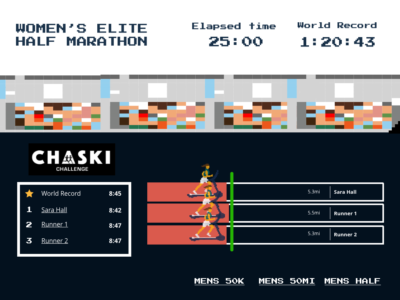
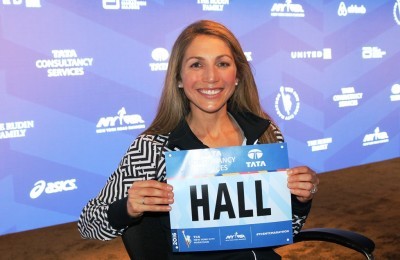
“A lot of people are really fit out there right now and have nothing to do with it,” Andrews says. “So we wanted to do that. And then just create a really compelling, fun, conversation-provoking event that people can watch on a Saturday night and have fun with.”
Similar to the Quarantine Backyard Ultra, the Chaski Challenge will feature a free live online broadcast and tracking of the record attempts around the country with cameras aimed at each elite runner’s treadmill. 2016 Olympian Marielle Hall and ultrarunner Kris Brown (13th at 2019 Western States 100) will serve as commentators.
“Chaski Endurance Collective, which is my coaching collective, we have a bunch of different athletes from different areas on staff and we were kind of just bouncing around ideas and talking about what could we do that’s kind of building off what Quarantine Backyard Ultra did really well, because that event just absolutely crushed it,” Andrews says.
Andrews also felt the inclusive nature of the Quarantine Backyard Ultra — anyone could sign up and compete — was one of the keys to its success, and to that end, the Chaski Challenge will feature free-to-enter 5k and 50k races, which anyone can sign up for and complete during a 24-hour window beginning on June 5 at 4 p.m. ET (there is an optional donation to Feeding America’s COVID-19 relief efforts).
At 6 p.m. ET on June 6, the broadcast will begin with the men’s 50k, which features Andrews, 2014 world 100k champ Max King, and Quarantine Backyard Ultra champion Mike Wardian (2:54 50k pb). Midway through that race, the men’s half marathon (featuring 61:51 man John Raneri) and the women’s half marathon (featuring Hall and 2:27 marathoner Renee Metivier) will begin. Mario Mendoza will also be attempting to break the 50-mile record; that attempt will begin prior to the broadcast. The current treadmill world records for each event are as follows (the men will also try to break the marathon record en route to 50k):
Women’s half marathon: 1:20:43, Jenna Wrieden, USA, 2014
Men’s half marathon: 1:03:37, Tyler Andrews, USA, 2015
Men’s marathon: 2:20:45, Paul Zwama, Netherlands, 2018
Men’s 50k: 2:56:35, Matthias Kyburz, Switzerland, 2020
Men’s 50-mile: 4:57:45, Jacob Puzey, USA, 2016
Andrews chose those events because he believes each record is ripe for the taking. The 50k record has been broken three times already this year; both Wardian and Mendoza are former holders of the record.
“We are 100% sure that we are going to break these records in this race,” says Andrews. “There’s zero question. The women’s half marathon mark is 1:20. I’m pretty sure that women out there have done that in training before and not recorded it. We’re not just looking to break these; we want to make these legitimate. We want to have actual, really good athletes just totally destroy them and set them way out of reach.”
Andrews feels confident he is just as fit as when he ran 2:46 for 50,000 meters in 2018; on Sunday, he ran a workout of 7 x 5k (16:19, 16:20, 16:20, 16:16, 16:11, 16:07, 15:51) with 1k recovery for a total of 41k on the treadmill in 2:16. He will be making the attempt in a room that doubles as his office and a storage room for his dad’s clothes.
“There’s a TV inside the cabinet [in front of the treadmill],” Andrews says. “I don’t watch television when I’m running, but I actually kind of like it because it’s almost a black mirror, so I can see my upper running form, so I can see if I’m starting to list to one side or slouch a little bit.”
Hall bouncing back from Olympic Trials disappointment
Andrews has run into one issue with the Chaski Challenge: Hall will not be able to run her portion of the event live. Instead, she will record her attempt this week, and it will be played at the same time as the other attempts on the broadcast next week. Still, she is excited to give it a go.
“It’s a tough time for all sports, but especially with ours including the masses, people need things to stay motivated or to get a benchmark of fitness,” Hall says. “I wanted to support that and it will be nice to get a benchmark of fitness for myself in the process and hopefully provide some entertainment to people.”
Hall’s most recent race was the US Olympic Marathon Trials in Atlanta on February 29, where she dropped out after 22 miles. Hall says her recovery has been “a process.”
“I wanted that team more than any other race of my career, so I think I’m still somewhat getting over the disappointment and I think I’ll always look back on it with frustration,” Hall says.
After falling short in the Marathon Trials, Hall’s initial plan was to give the track trials a go in either the 5,000 or 10,000; even once they were postponed, her recent training has focused on those distances. She eventually plans to transition into a buildup for a fall 2020 marathon (if they happen) before returning to the track for the 2021 Olympic Trials.
For a woman who has run 1:08 for a half, 1:20 should be a piece of cake — theoretically. But Hall is not peaking for the Chaski Challenge. And since she rarely runs on treadmills, she doesn’t want to risk injury by giving a full race effort. In addition, she’ll likely be running at almost 7,000 feet in Flagstaff — which Hall says usually knocks 15 seconds per mile off her tempo pace. Still, record pace is just 6:10 per mile, which is very attainable for Hall, even with those caveats.
Hall won’t be able to make her attempt from the comfort of home as her treadmill is currently broken. Her plan is to head to a gym (which are now open in Arizona) and take her shot there. Unlike most half marathon record attempts, however, Hall will be able to have her four daughters cheer her on every step of the way — if they choose to.
“I’ll create a playlist to give me some entertainment and the girls will probably cheer me on, but will likely get bored after a few minutes and wander off,” Hall says.
Login to leave a comment
Sara Hall, will be shooting for the women’s treadmill half marathon record on June 6 in Chaski Challenge
Inspired by the success of last month’s Quarantine Backyard Ultra, a handful of elite runners will attempt to break treadmill world records across five distances next week. Sara Hall, the fastest American female marathoner of 2019, is the headliner, and will be shooting for the women’s treadmill half marathon record of 1:20:43 (Hall’s pb is 1:08:58).
The event, which will be held on Saturday, June 6, and is known as the Chaski Challenge, is the brainchild of Tyler Andrews, a 2:15 marathoner who ran a world best of 2:46:06 for 50,000 meters on the track in 2018 (LRC recorded a podcast with him shortly before that race).
Before the coronavirus pandemic hit, Andrews had planned to spend the spring training with Jim Walmsley in Flagstaff as the two men prepared to race the famed Comrades Marathon in South Africa. Instead, Andrews is now based at his parents’ house in Concord, Mass., but is still training hard and wanted to create an opportunity to allow himself and others to demonstrate their fitness.
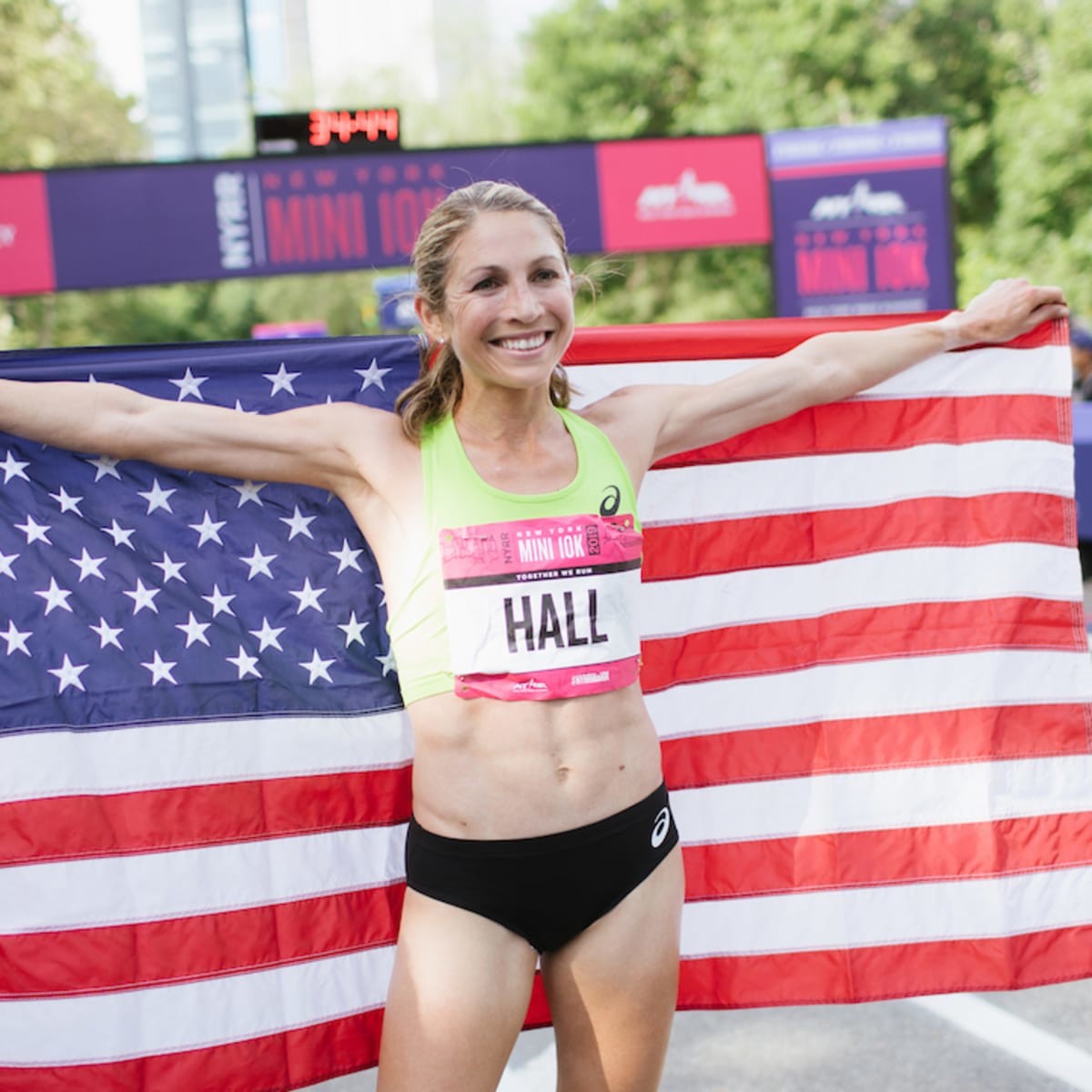
“A lot of people are really fit out there right now and have nothing to do with it,” Andrews says. “So we wanted to do that. And then just create a really compelling, fun, conversation-provoking event that people can watch on a Saturday night and have fun with.”

Similar to the Quarantine Backyard Ultra, the Chaski Challenge will feature a free live online broadcast and tracking of the record attempts around the country with cameras aimed at each elite runner’s treadmill. 2016 Olympian Marielle Hall and ultrarunner Kris Brown (13th at 2019 Western States 100) will serve as commentators.
“Chaski Endurance Collective, which is my coaching collective, we have a bunch of different athletes from different areas on staff and we were kind of just bouncing around ideas and talking about what could we do that’s kind of building off what Quarantine Backyard Ultra did really well, because that event just absolutely crushed it,” Andrews says.
Andrews also felt the inclusive nature of the Quarantine Backyard Ultra — anyone could sign up and compete — was one of the keys to its success, and to that end, the Chaski Challenge will feature free-to-enter 5k and 50k races, which anyone can sign up for and complete during a 24-hour window beginning on June 5 at 4 p.m. ET (there is an optional donation to Feeding America’s COVID-19 relief efforts).
At 6 p.m. ET on June 6, the broadcast will begin with the men’s 50k, which features Andrews, 2014 world 100k champ Max King, and Quarantine Backyard Ultra champion Mike Wardian (2:54 50k pb). Midway through that race, the men’s half marathon (featuring 61:51 man John Raneri) and the women’s half marathon (featuring Hall and 2:27 marathoner Renee Metivier) will begin. Mario Mendoza will also be attempting to break the 50-mile record; that attempt will begin prior to the broadcast.
by Jonathan Gault
Login to leave a comment
In challenging times, Of all the communities within the sport of athletics, mountain runners spend more time outdoors than most
So when restrictions for outdoor activities and exercise are introduced, as has been the case in recent weeks during the coronavirus pandemic, it has been particularly challenging to maintain a decent level of fitness for runners who routinely log anywhere between 100 to 200 kilometres per week.
The World Mountain Running Association (WMRA) spoke to some of the world’s leading mountain runners and found that what united them all was a stronger sense of community and a feeling that this crisis puts running into perspective.
Francesco Puppi, the 2017 world long distance mountain-running champion, describes the situation in Italy.

“Life has changed drastically,” he said. “Everyone is supposed to stay at home and avoid social contacts as much as possible: it's the only weapon we have to fight the virus, and we don’t know how long all this will go on.
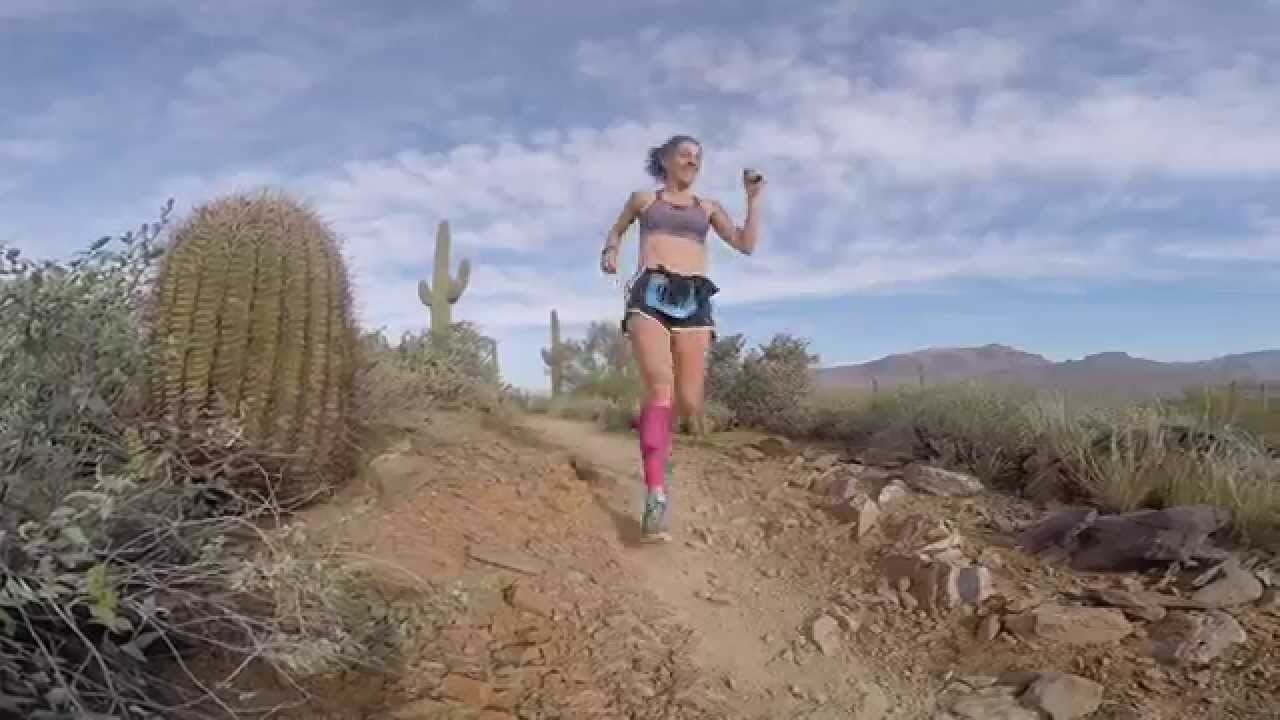
“Running is permitted but only under particular circumstances. I am currently training, just at a slightly lower intensity than before. I think everyone in this situation should have the sensibility to understand if, when and how to run. It should be done with discretion and care. This is a form of respect for those who are suffering.
“It doesn’t mean that all the work I did has been wasted,” adds Puppi, who had been due to compete at the Rotterdam Marathon. “I am still proud of what I managed, of the big effort I put into those 110-mile weeks, the sore legs, the long workouts, of the improvements and setbacks I’ve experienced on this journey. It’s just a matter of re-thinking our goals.
“Keep on running because this is something we love and makes us feel good, even in the worst situation.”
For 2019 WMRA World Cup winner Andrew Douglas, the situation in the UK, and in his home nation of Scotland, is ‘rapidly changing’.
“I’m just trying to appreciate every chance I get at the moment to put my trainers on and head out for a run,” said Douglas, who is anticipating the introduction of stricter measures like those in Spain, France and Italy.
“Undoubtedly it’s disappointing to see this having such a profound impact on races, but personally the effect it has on me pales in comparison to the much bigger issues facing society, so ultimately it’s just about getting some perspective. I had my best ever season last year so that’s something I’m fortunate to be able to have at the back of my mind.
“Like most people, I have not experienced anything like this in my lifetime, so as much as my working environment is changing, my training at the moment is the one ordinary thing I can rely on for the moment in these extraordinary times.”
“When pubs are closed in Ireland, then it's definitely serious,” said Irish runner Zak Hanna.
“The mountains aren't going anywhere any time soon, so just keep calm, weather the storm and we will all come through this. As the Irish Taoiseach Leo Varadkar said, ‘Let it be said that when things were at their worst, we were at our best’.”
Mimmi Kotka, who is from Sweden but lives in France, is into her third day of confinement. The 2018 Marathon du Mont Blanc winner is allowed to exercise outdoors but must stay close to home. “You have to carry a certificate for this too, stating where you live and what your errand outside is,” she says. “Adjusting to new circumstances is part of being human; we need to deal with it. If you’re healthy, be grateful for that. And this is about doing what’s right; after all, running is a leisure activity.”
“In order not to clog up extra resources in hospitals, we're not allowed to go very high up into the mountains,” adds Britain’s Sarah Tunstall, who is based in France. “The mountain rescue teams and workers who control the avalanches at this time of the year are also isolating so it makes the mountains especially dangerous.”
British mountain runner Natalie White, who is currently based in northern Italy, one of the hardest hit areas, says: “Doing our part is going to help not just ourselves but others. Some areas are allowing runners to go out, but close to home and solo. That in itself is a positive to be grateful for.”
It’s not just the athletes who are affected either. Competition organisers have also been hit by the crisis. US runner Max King, who is also race director of the recently cancelled Bend Marathon, asks his fellow athletes for their understanding in these difficult times.
WMRA Council member Nancy Hobbs urges runners to practise social distancing. “It is challenging when running with someone else to not speak, of course, and the further apart you get from someone, the harder it is to communicate,” she says. “However, doing track workouts with friends can be modified. Being creative is the key.
“One of the most important things is to check in with your running friends,” adds Hobbs. “It’s crucial to support one another.”
by World Athletics
Login to leave a comment
Bend Oregon ranks with any Town in America as a Trail running destination
Login to leave a comment
Way Too Cool 50k is about breathtaking trails, spirited aid stations and amazing views
Login to leave a comment
This advice will help make you a better Trail Runner from someone who knows
Trail Running
Login to leave a comment
Max King and Camile Herron Honored by USATF
Login to leave a comment


